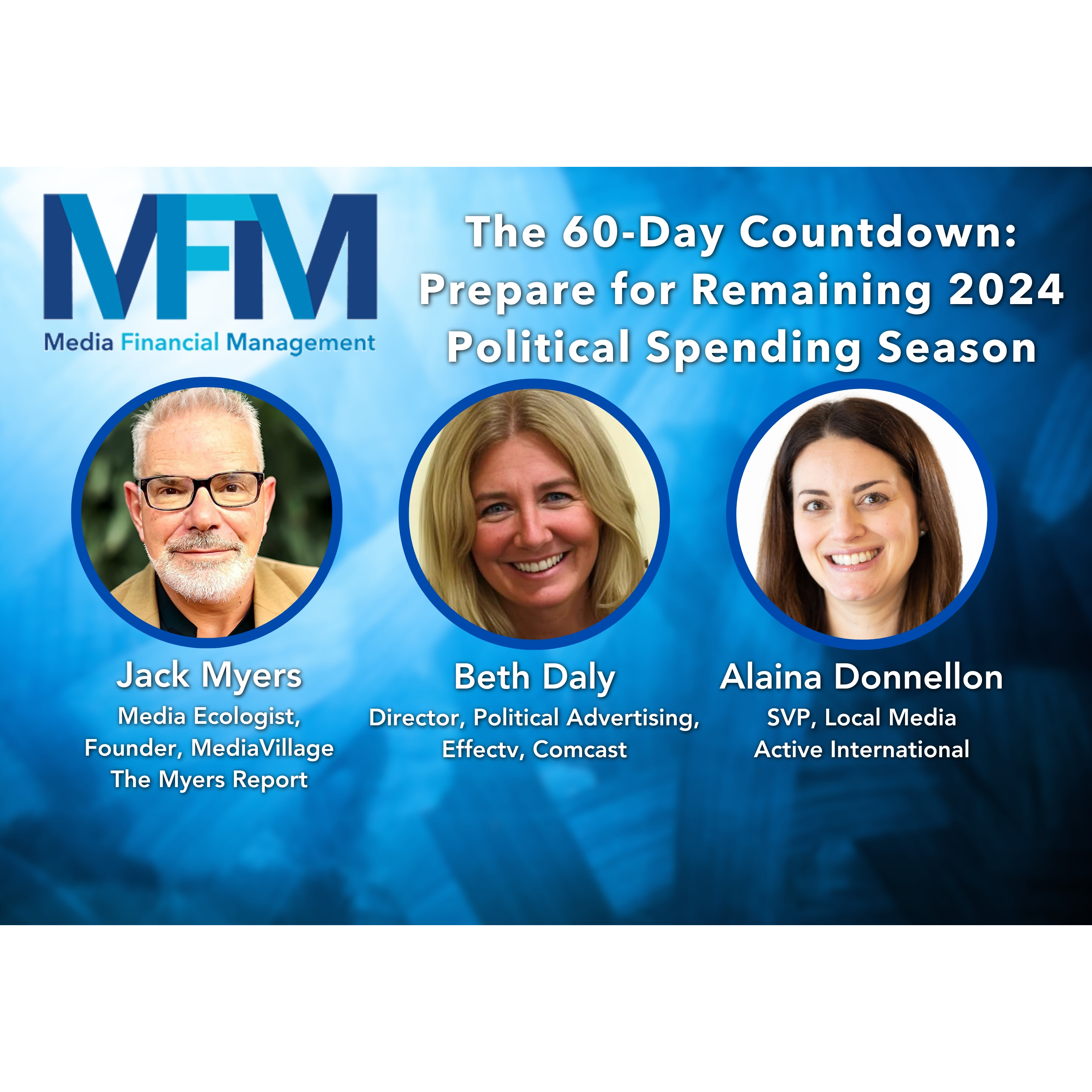Less Than Six Weeks Out: How Political Advertising Buyers and Sellers are Navigating the 2024 Election

We have just passed the six-week mark to the 2024 presidential election. With the first Trump-Harris debate in the rearview mirror (and a second one currently an unknown), the two campaigns are in a full-on race to reach audiences with the two presidential candidates’ messages in an effort to persuade Americans to vote for them and their running mates.
With the irregularities of the 2024 election – punctuated by President Joe Biden exiting the race on July 21 – political spending is estimated to surpass even the hotly contested 2020 presidential race. On September 10 – virtually the 60-day countdown to election day, MFM hosted a Town Hall moderated by Jack Myers, media ecologist and founder of MediaVillage. Myers brought on two experts – Alaina Donnellon, Senior Vice President, Local Media at Active International, and Beth Daly, Director of Political Advertising at Effectv – to give participants a clear understanding of the spending landscape through this election cycle.
After positing “there’s a lot of unpredictability and it’s a bit of a guessing game [at both the local and national levels],” Myers asked the two panelists about the political trends they’re observing in this election they might not have seen in past elections.
Effectv’s Beth Daly, who has been on the sell side of political ads for many years, said “It used to be broadcast/cable/radio, but now political buyers and consultants are very sophisticated. They’re not looking at what they’re buying, but who the audience is…they’re buying that media irrespective of the platform – they just want to reach their audience.”
Alaina Donnellon, who’s on the buy side, said she has noted “a significant increase in spend on digital platforms. It didn’t come onto the scene until 1-2 elections cycles ago, but Harris is spending half of a nearly $400 million budget on digital. It’s more than we even anticipated.”
Myers followed with “What percentage of incremental ad spend is going to digital?” with Donnellon answering that while AdImpact had previously predicted 10% going to digital, she thinks it may be as high as 15%. Daly reminded viewers that “…digital is just one tool in the toolshed – cable, radio, network, spot broadcast – they’re just buying audiences” and that local will be big: “The six battleground states [PA, AZ, GA, MI, NV and WI] pare going to buy local. These elections are local, so local media makes the most sense.”
The panelists were quick to point out the distinctions between ad spending by the candidates themselves, which is capped, and spending by PACs, which has no cap, but whose ads must go through a review process. Donnellon said “PACs will continue to spend significantly-- a lot of money to keep their messages on the air – and they’re high prices and have unlimited fundraising”; Daly noted “PACs tend to be more aggressive. Well over 75% of our spending has been PAC-related.”
One of the three polling questions webinar participants were asked was “How are you planning to manage the potential surge in political ad spending during the final weeks of the election cycle?” and 54% of respondents said they planned to reallocate ad inventory, giving political ads priority over traditional advertisers. Said Daly: “When inventory gets tight, candidates can buy at a higher rate – and many do.” Donnellon added, “It’s challenging to manage all this inventory…we’re definitely seeing premiums apply to political advertising.”
Myers then asked about the significance of Advanced TV and set-top boxes for data collection and analysis, microtargeting and revenues. The two panelists seemed to agree that while these technologies are still comparatively new, Advanced/addressable TV will be a significant source of revenue. Daly commented: “There’s a real appetite for the microdata these political campaigns and PACS have access to.”
Do both panelists think the election may result in $10B of ad spending or more – a number predicted by several analysts? At the time the webinar was recorded, Donnellon said: “I think so; it’s more a shift in where the money is being spent. [We had] a slower start – more so for state races. Now that we’re getting closer to the election, there’s more fundraising on the presidential campaign level being backloaded into these last 60 days. Daly added “Right now I’d say they’re going to spend it all, and they’ll spend it where it makes sense for them.”
One sentiment both panelists echoed is the critical nature of constant communication between campaigns, ad buyers, ad sellers, and the advertising platforms. Donnellon said: “We can’t stress communications enough. We have to make sure things are still moving, and if we have to make adjustments, we can.”
Daly concurred: “The onus is on the sales organizations to serve the political clients really well. It’s a good business – there’s cash up front, and there’s no posting. We work late hours and weekends, [the buyers are] spending a lot of money, and the sales organizations need to cater to those high value clients. It all comes down to communication and the approach, staying close to the buyers and their clients.”
If you’re an MFM member and missed this fast-moving and very timely Town Hall webinar, you’ll have the opportunity to watch (or rewatch) it in early October. Just log in to your MFM member account and go to the Knowledge Center to view.
Posted at MediaVillage through the Thought Leadership self-publishing platform.
Click the social buttons to share this story with colleagues and friends.
The opinions expressed here are the author's views and do not necessarily represent the views of MediaVillage.org/MyersBizNet.


